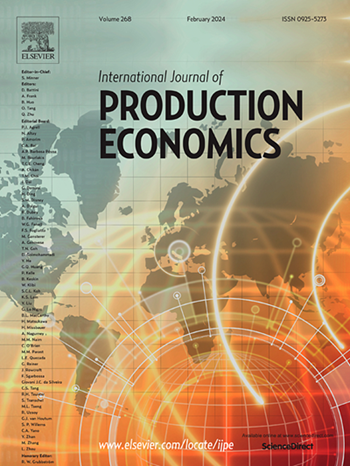平台在绿色与非绿色产品竞争中的作用:区块链透明度与销售合同选择
IF 10
1区 工程技术
Q1 ENGINEERING, INDUSTRIAL
引用次数: 0
摘要
通过提高透明度,区块链促进了产品的绿色认证,提高了消费者的信任和购买绿色产品的意愿。本研究考察了区块链透明度和不对称销售合同对上游竞争和搭便车效应的影响,重点关注绿色度和供应链利润。在我们的模型中,下游平台向不对称绿色和非绿色供应商提供转售或代理合同。首先,研究发现在低(高)佣金率下,非绿色供应商的转售合同和绿色供应商的代理(转售)合同在提高绿色度方面最有效。其次,区块链的采用持续增加了非绿色供应商的利润,但并不总是有利于绿色供应商。值得注意的是,较高的区块链成本降低了绿色供应商的利润,但可能增加非绿色供应商的利润。第三,平台盈利能力随市场条件的变化而变化,四种合同形式在一定条件下都是最优的。具体而言,绿色供应商的转售合同在低佣金率下是最优的,但随着佣金率的上升而转向代理合同,而非绿色供应商在更高的佣金率阈值下经历这种转变。值得注意的是,在极高的佣金率和bbb的透明度下,与绿色供应商恢复转售合同将使平台利润最大化。最后,在适度低佣金率和高透明度的条件下,非绿色供应商的转售合同与绿色供应商的代理合同相结合,在符合平台盈利能力和整体供应链效率的最佳策略的同时,实现了最高的绿色度。本文章由计算机程序翻译,如有差异,请以英文原文为准。
Platform's role in green vs. non-green product competition: Blockchain transparency and selling contract selection
By enhancing transparency, blockchain facilitates product greenness verification, boosting consumer trust and willingness to pay for greener products. This study examines the impact of blockchain transparency and asymmetric selling contracts on upstream competition and free-riding effects, focusing on greenness and supply chain profits. In our model, the downstream platform offers reselling or agency contracts to the asymmetric green and non-green suppliers. First, the findings reveal that under a low (high) commission rate, a reselling contract for the non-green supplier and an agency (reselling) contract for the green supplier is most effective in enhancing greenness. Second, blockchain adoption consistently increases the non-green supplier's profits but does not always benefit the green supplier. Notably, higher blockchain costs reduce the green supplier's profits but may increase the non-green supplier's profits. Third, platform profitability varies with market conditions, and each of the four contract forms can become optimal under certain conditions. Specifically, a reselling contract with the green supplier is optimal under a low commission rate but shifts to an agency contract as the rate rises, while the non-green supplier undergoes this shift at a higher rate threshold. Notably, at an extremely high commission rate and blockchain transparency, reverting to a reselling contract with the green supplier maximizes platform profits. Finally, under a moderately low commission rate and high transparency, combining a reselling contract for the non-green supplier with an agency contract for the green supplier achieves the highest greenness while aligning with optimal strategies for platform profitability and overall supply chain efficiency.
求助全文
通过发布文献求助,成功后即可免费获取论文全文。
去求助
来源期刊
CiteScore
21.40
自引率
7.50%
发文量
266
审稿时长
52 days
期刊介绍:
The International Journal of Production Economics focuses on the interface between engineering and management. It covers all aspects of manufacturing and process industries, as well as production in general. The journal is interdisciplinary, considering activities throughout the product life cycle and material flow cycle. It aims to disseminate knowledge for improving industrial practice and strengthening the theoretical base for decision making. The journal serves as a forum for exchanging ideas and presenting new developments in theory and application, combining academic standards with practical value for industrial applications.

 求助内容:
求助内容: 应助结果提醒方式:
应助结果提醒方式:


